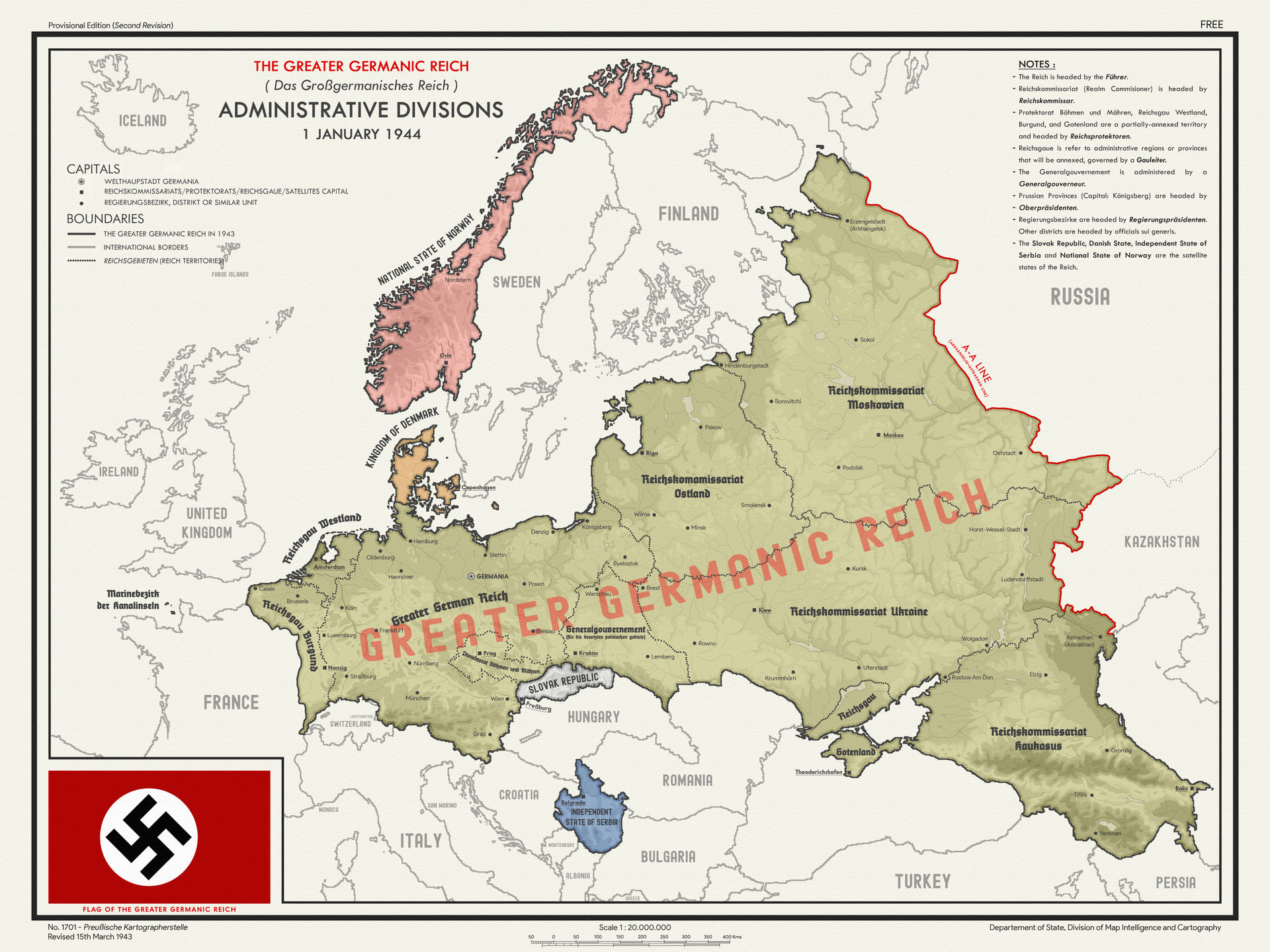 PreussenArchiv on DeviantArthttp://creativecommons.org/licenses/by-nc-nd/3.0/https://www.deviantart.com/preussenarchiv/art/The-Greater-Germanic-Reich-1944-1031414158PreussenArchiv
PreussenArchiv on DeviantArthttp://creativecommons.org/licenses/by-nc-nd/3.0/https://www.deviantart.com/preussenarchiv/art/The-Greater-Germanic-Reich-1944-1031414158PreussenArchivDeviation Actions
Description
The Greater Germanic Reich, fully styled as the Greater Germanic Reich of the German Nation (German: Großgermanisches Reich der Deutscher Nation), is the official state name of more commonly known as Germany, a country in Central Europe.
[Alternative History]
After the Allied surrender to Germany following France's defeat in June 1940, Germany launched Operation Barbarossa on 22 June 1941 with the intention of defeating the Soviet Union in a swift offensive expected to last only three months. The Axis forces initially succeeded, inflicting major defeats on the Red Army before being halted just short of Moscow in November/December 1941. Despite capturing significant territories and key industrial centers, the Soviet Union remained in the fight. In the winter of 1941–42, the Soviets launched successful counteroffensives, pushing back the German threat to Moscow. Despite setbacks, Hitler aimed for complete destruction of Russia, necessitating control over the oil resources of the Caucasus. By February 1942, the German Army High Command (OKH) devised plans for a follow-up campaign to Barbarossa, targeting the Caucasus region. On 5 April 1942, Hitler outlined the strategy in Führer Directive No. 41, known as "Case Blue" (Fall Blau). This directive outlined the main goals for the 1942 summer campaign on Germany's Eastern front: holding attacks for Army Group Centre, capturing Leningrad and linking up with Finland for Army Group North, and capturing the Caucasus region for Army Group South, with the primary focus on the Caucasus.
The German offensive began on 28 June 1942, with the Fourth Panzer Army driving towards Voronezh. Due to a disordered Soviet retreat, the Germans advanced rapidly, bolstering Wehrmacht confidence for the upcoming major offensive. By 24 December, five months after the offensive commenced, forward elements of the Fourth Panzer Army had reached Baku and became entangled in the battle to capture the city. The summer offensive succeeded, leading to the capture of the oil fields in Baku, Grozny, and Maikop. This victory enabled the Germans to resupply their low fuel stock and denied these resources to the Soviet Union, precipitating the collapse of the Soviet war effort. With the capture of the Caucasus oil fields, Stalin realized the Soviet oil supply for the war was running out.
Following the capture of the Caucasus oil fields in December 1942, the German High Command planned an offensive to crush the Soviet forces in the southern sector of the Eastern Front. To divert Soviet attention from the thrust that would lead to the Battle of Stalingrad, on 29 January 1943, the High Command ordered the "earliest possible resumption of the attack on Moscow" by Army Group Centre. This offensive, known as "Operation Kremlin" (Fall Kreml), aimed to encircle Moscow and end the war that year.
On 2 April 1943, during the spring of that year, German forces resumed attacks on the Stalingrad, Leningrad, and Moscow fronts. AG North was divided into two fronts, positioned on the Finnish front alongside Finnish troops, and in the southern city of Leningrad. The city was captured within a week, while on the Stalingrad front, German forces initiated an artillery bombardment in the middle of the city as a diversion for crossing the Volga River. This tactic successfully surrounded the city, leading to the surrender of Soviet troops. Moscow fell after an attack carried out by AG Centre, combining Italian, Romanian, and Hungarian troops. The city was encircled within five weeks. Unable to escape Moscow, Stalin committed suicide on 6 May. The German Banner of Victory was raised by Wehrmacht soldiers on the Kremlin Palace of Congresses building in Moscow on 7 May. In the chaos, the Soviet Union surrendered to Germany and signed the Soviet Instrument of Surrender on 8 May 1943.
Führer Adolf Hitler declared a Thousand Year Reich, and 8 May was observed as a commemoration day known as the Victory Day. Leningrad and Stalingrad were renamed Hindenburg and Ludendorff in honor of the heroes of the First World War.
Amazing map!
It is great to see you trying to improve your skills.